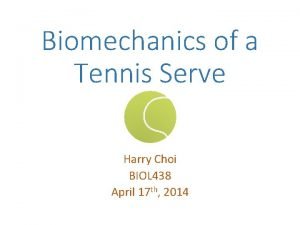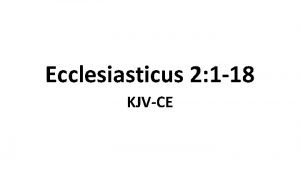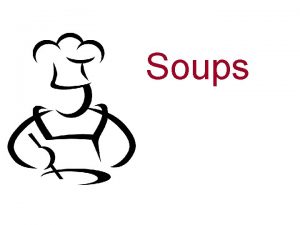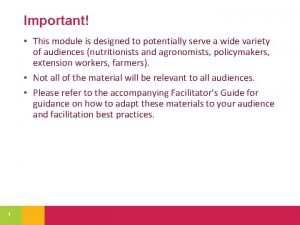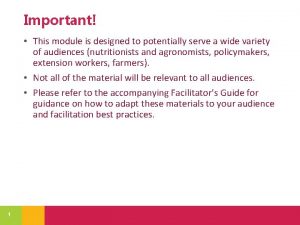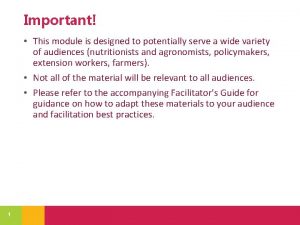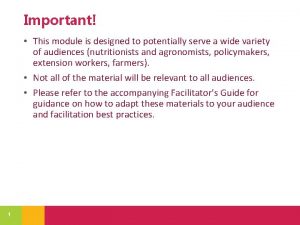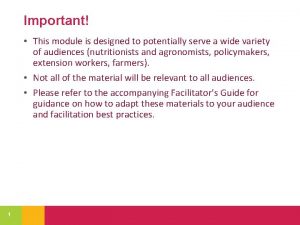Important This module is designed to potentially serve






























































































- Slides: 94

Important! • This module is designed to potentially serve a wide variety of audiences (nutritionists and agronomists, policymakers, extension workers, farmers). • Not all of the material will be relevant to all audiences. • Please refer to the accompanying Facilitator’s Guide for guidance on how to adapt these materials to your audience and facilitation best practices. 1

Legend Icon Xm Description Expected Duration, minutes Quick Review/Survey Questions Brainstorming Session Discussion Session Group Activity Animated Slide End of Animation 2

Legal • Unless otherwise noted, all images copyrighted to International Potato Centre. • Attribution-Non. Commercial-Share. Alike 2. 0 Generic (CC BYNC-SA 2. 0) 3

Everything You Ever Wanted to Know About Sweetpotato Topic 4: Nutrition and Orange-fleshed Sweetpotato

Nutrition and Orange-fleshed Sweetpotato Introduction 5

Welcome During this session, we will discuss nutrition and explore what we mean by good nutrition, why it is important and the different ways we can be malnourished. We will also focus on nutritional benefits of sweetpotato. 6

Unit 1 Nutrition 7

Objectives By the end of this unit, you should be able to: • Explain the difference between macro and micronutrients. • Discuss what is meant by a healthy balanced diet, and why it is important. 8

Types of Food • Foods can be categorised based on their main nutrient type and function: − Carbohydrates (energy giving) − Proteins (body building and energy giving) − Fats (energy storage and giving, insulation) − Vitamins and minerals (support and protect body development and functioning) • In addition, we also need to: − Eat fibre (to help move food through the digestive track), and − Drink water (which is a key component in many bodily functions) 9

Macronutrients and Micronutrients • Carbohydrates, proteins and fats are called macronutrients because our bodies need them in large amounts. • Vitamins and minerals are called micronutrients because they are needed in small amounts. 10

Healthy Balanced Diet • It is important to eat food from each group daily. • Nutrient requirements vary depending on: − Age − Gender − Physical activity − Pregnancy − Breastfeeding • Healthy balanced diet provides adequate food for energy and nutrients. 11

Importance of Healthy Nutrition • Nutrition impacts human growth and development • Adequate nutrition is critical during pregnancy, breastfeeding and childhood • Malnutrition can lead to: − Poor growth − Being less active − Frequent illnesses • It is difficult to reverse malnutrition 12

Quick Review 1. What are the four main types of food, based on their main nutrient type? 2. What is the difference between macronutrients and micronutrients? 3. What could be some of the consequences of malnutrition? 13

Key Points • Foods are categorised based on the main nutrients they contain: these are carbohydrates, proteins, fats, vitamins and minerals. • To stay healthy, we need to consume a balanced diet of a diverse range of foods containing these different nutrients; we also need to consume fibre and drink plenty of water. • We need to consume macronutrients in large amounts. These give us energy and include: carbohydrates, proteins which also help us build and repair our bodies, and fats which supply fatty acids and help us absorb some vitamins. • We also need small amounts of vitamins and minerals, which we call micronutrients, which help our bodily functions and protect us from disease. • Each micronutrient has a very specialized role in supporting growth and maintaining health. 14

Unit 2 Malnutrition 15

Objectives By the end of this unit, you should be able to: • List the three main types of malnutrition. • Explain how poverty can cause malnutrition. • Discuss the consequences of malnutrition at individual, household and national level. • State how many African children under 5 years old are stunted, underweight or overweight. • Discuss the causes and prevalence of hidden hunger. 16

Types of Malnutrition • Malnutrition is simply ‘Poor Nutrition’ • There are several types of malnutrition: − Undernutrition • Wasting: Low weight-for-height • Stunting: Low height-for-age • Underweight: Low weight-for-age − Micronutrient-related malnutrition • Micronutrient deficiencies • Micronutrient excess − Malnutrition can also be overnutrition, especially of the ‘wrong’ types of food, leading to overweight, obesity and diet -related non-communicable diseases, such as heart diseases, stroke, diabetes and even some cancers 17

Causes of Malnutrition • Number 1: Poverty − Limited food − Bad quality Droughts Floods Earthquakes Failed crops Interrupted food supplies • Wars • Civil disturbances • • • 18

Impact of Malnutrition 19

Malnutrition in African Children under 5 is a severe problem in African children under 5: • Malnutrition − 14 million are categorised as wasted − 59 million are stunted − 10 million are overweight • Recent study on the Cost of Hunger revealed that the annual cost of child undernutrition ranges from US $4. 7 billion in Ethiopia to US $92 million in Swaziland. • A recent seven-year study also revealed that Africa is the only region where malnutrition increased. 20

Macronutrient Malnutrition • Lack of the macronutrients – carbohydrates, proteins or fats • Protein-Energy Malnutrition (PEM) is the most common • Severe cases of PEM can lead to kwashiorkor or marasmus. 21

Micronutrient Malnutrition • Micronutrient deficiency (“hidden hunger”) is lacking vitamins and/or minerals. • Detrimental to: − Growth − Immunity − Health 22

Foods to Address Malnutrition • Nutrient rich: Groundnut, sesame • Energy: Cereals, sweetpotato, cassava roots • Animal Foods: Meat, eggs, milk • Fruits • Vegetables 23

Quick Review 1. What are the types of malnutrition? 2. What is the number one cause of malnutrition? 3. What is ‘hidden hunger’? 24

Key Points • There are three forms of malnutrition: − Undernutrition (insufficient food intake, not enough calories, or protein or micronutrient deficiencies – wasting, stunting, underweight); − Micronutrient deficient (not enough vitamins and minerals – hidden hunger), − Overnutrition (too many calories – overweight and obesity) • Poor nutrition in the first 1, 000 days of a child’s life can lead to irreversible stunting, poor micronutrient status and decreased cognitive ability 25

Unit 3 Nutrients 26

Objectives By the end of this unit, you should be able to: • Describe which of the foods commonly consumed in your location are good sources of carbohydrates, proteins, fats, vitamins and minerals. • Name at least four important vitamins and minerals and explain what health problems deficiencies in each of them causes. • Explain the importance of vitamin A in the diet and discuss the prevalence and implications of vitamin A deficiency (VAD) particularly in young children and pregnant women. 27

Nutrient Classification Essential nutrients • Not synthesised in body • Supplied through food: − Proteins − Fats − Carbohydrates − Minerals − Fibre − Water 28 Non-essential nutrients • Synthesised in body • Required non-essential nutrients are: − Vitamin D − Amino acids − Cholesterol

Carbohydrates • The role of carbohydrates: − The main source of energy − Fibre helps digestion, bowel health and optimal cholesterol levels • Main source of carbohydrates is plants (e. g. potato, sweetpotato, cereal grains, legumes) • Carbohydrates can be in the form of fibre, starch or sugar • Excess carbohydrates are converted to fat 29

Forms of Carbohydrates • Starch • Sugar − Broken down in body − Slow and steady energy release − Contained in foods like maize, rise, wheat, oats, sweetpotato • Fibre − Plant-based food − Absorbs water − Rids bodily waste − Contained in foods like vegetables, fruits (especially peel on), whole grains 30 − Quickly absorbed − Concentrated energy − Excess consumption can lead to overweight or even obesity − Contained in fruit, processed sugar cane

Proteins • The role of proteins: − Building blocks of life − Build and repair body tissues, such as muscles, bones and organs, blood, skin and hair − Necessary for blood clotting − Keep the immune system strong by developing antibodies to fight disease − A major component of the body’s transportation system that carries oxygen and nutrients to all cells • Sources of proteins: − Animal foods, such as meat, poultry, fish, eggs, milk − Vegetables, such as dried beans, lentils, legumes, pumpkin seeds, soy bean 31

Fats (Lipids) • Role of fats: − Rich source of energy and Essential Fatty Acids (EFAs) − Helps absorb fat-soluble vitamins (A, D, E, K) − Important for brain and central nervous system development − Important for manufacturing hormones − Protects cells and internal organs − Can cause weight gain and eventually obesity • Sources of fats: − Animal, such as meat, dairy, fatty fish (contains omega-3 essential fatty acids), poultry, eggs − Vegetables, such as seeds, nuts, olives 32

Vitamins and Minerals (Micronutrients) • Role of micronutrients: − Each micronutrient has a specific function in enabling bodily processes − Micronutrients fight infection and participate in chemical/enzymatic reactions − Help build tissues (although not part of those tissues) − Serve as antioxidants − Micronutrient deficiency leads to various diseases, some severe • Types of micronutrients: − Fat-soluble: Don’t dissolve in water or body fluids, can be stored − Water-soluble: Lost in urine, can’t be stored • Plant and animal sources, e. g. leafy greens, fruits, vegetables, meat and fish, most whole and natural foods − Sweetpotato is rich in beta-carotene 33

Common Micronutrient Deficiencies • Deficiencies in iron, iodine, zinc and calcium are common and a serious public health concern. 34

Iron Deficiency • Iron deficiency (anaemia) leads to reduced disease resistance and poor growth and development. • Iron-rich food sources are red meats, liver, fish, poultry and eggs, beans and leafy green vegetables. 35

Iodine Deficiency • Iodine deficiency can result in goitre, and mental retardation in children. • Iodine-rich food sources need to be regularly consumed and include seafood, saltwater fish, seaweed and iodised salt. 36

Zinc Deficiency • Zinc deficiency can affect the central nervous system and the brain. • Zinc-rich food sources are meat, milk, cheese, eggs, shellfish, wholegrain cereals, nuts and pulses. 37

Calcium Deficiency • Calcium deficiency leads to reduced bone density. − Calcium consumption is particularly important during childhood and adolescence when bones are growing. • Calcium-rich food sources are milk, cheese, yoghurt, small fish and cabbage. 38

Quick Review 1. What is the difference between essential and non-essential nutrients? 2. What is the role of carbohydrates? 3. What type of food is called ‘building blocks of life’? Why? 4. What are the most common micronutrient deficiencies? 39

Key Points • Although we only need vitamins in small/ micro amounts they are still vitally important, and a lack of any vitamin cause serious health problems. • Vitamin A food sources include liver, eggs, dark orange or green coloured vegetables and fruits such as orange-fleshed sweetpotato, mangoes, spinach, milk. • Vitamin A helps maintain our eyesight, immune system, cell division, growth and reproductive systems. An estimated 250 million preschool children are vitamin A deficient, and a large proportion of pregnant women. • Vitamin D food sources include fish oils and liver and can also be synthesised by the body when our skin is exposed to sunlight. Vitamin D is important for bone formation and strength, and helps the immune system, brain, nervous system, skin, muscles and cartilage, kidneys, intestines and reproductive organs. 40

Key Points (cont. ) • Our bodies need minerals to form structures such as bones, teeth, nails, muscles, and red blood cells and to regulate chemical reactions. • Eating a varied and balanced diet will help ensure an adequate supply of most minerals. • Deficiencies in iron, iodine, zinc and calcium are common and a serious public health concern. 41

Unit 4 Tackling Micronutrient Malnutrition or Hidden Hunger 42

Objectives By the end of this unit, you should be able to: • Describe and compare four different approaches used for tackling micronutrient malnutrition. 43

Four Approaches to Tackling Malnutrition 1. Supplementation 2. Food fortification 3. Dietary diversification 4. Biofortification 44

Supplementatio n • Supplementation means taking a capsule, tablet, or injection containing the needed micronutrient(s). • Mega doses of vitamin A are given every 6 months in some areas where vitamin A-rich animal foods are too expensive. 45

Supplementation Cont. Advantages • Tends to be low cost per capita • Unlike fresh food, supplements are easy to store/transit. • UN refers to the first 1000 days of a child’s life as a window of opportunity for supplementation, maintaining brain function. • Fat-soluble vitamins given in mega doses that release slowly into the body. 46 Disadvantages • Many programs are expensive and must be donor-supported. • Short-term benefits • Targeted, yet difficult to reach the hard to reach population • Risk that it inhibits development of alternative and more sustainable programmes

Food Fortification • Food fortification means adding extra nutrients to foods to increase micronutrient value. • Fortification has been used in industrialized and semi-industrialized countries since the late 1800 s. 47

Food Fortification Cont. Advantages • Efficient, simple, inexpensive • Does not require people to change dietary habits • One input point (industry) 48 Disadvantages • Many people purchase food from local and informal markets, making it hard to institute programs. • Requires public and private partnership, political commitment • Young children can only eat small amounts of food and will require additional supplements. • Requires enforcement

Dietary Diversification • Changing household diets to include micronutrient-rich foods. • Increasing access to nutrient-dense foods • Achieved through social and behaviour programs 49

Dietary Diversification Cont. Advantages • Bioavailability of nutrients is often better than supplements, as long as there is sufficient oil in the diet. • Long term impact • Complementarity with other objectives • No external inputs needed 50 Disadvantages • Sometimes it is difficult to provide steady access to better foods • Food availability, supply chain disruptions could cause issues • High start-up costs • Long-term investment

Biofortification • Biofortification means growing foods with more total micronutrient content. • Means of biofortification: − Developing new strains through breeding − Using best varieties available 51

Biofortification Cont. Advantages • Builds on staple foods that poor households already enjoy • Reaches rural and urban populations—any area where supplementation or fortification may be difficult • Sustainable approach 52 Disadvantages • Takes time to implement • Public awareness needed

Quick Review 1. What are the four approaches to tackling micronutrient malnutrition? 2. What are the advantages of biofortification? 53

Key Points • Micronutrient malnutrition or ‘hidden hunger’ can be managed using a range or combination of different approaches, including: − Supplementation – taking a capsule or injection containing a sufficient amount of the deficient micronutrient. − Food fortification – adding an essential micronutrient to commonly consumed processed foods such as cooking oil, sugar, salt, flour. − Dietary diversification – increase the variety and quantity of micronutrient-rich foods, through social and behaviour change activities, often including the increased production of or access to nutrient-rich foods. − Biofortification – breeding varieties of a popular staple food crop with high amounts of at least one important micronutrient. • Each of the approaches has advantages and disadvantages. 54

Unit 5 The Nutritional Value of OFSP 55

Objectives By the end of this unit, you should be able to: • List at least five locally available foods that are rich in vitamin A. • Discuss how cooking, drying and storage processes effect beta-carotene levels in OFSP. • Describe the consequences of vitamin A deficiency. 56

Sources and Importance of Vitamin A • Sources of vitamin A include fruits, vegetables, including sweetpotato. Generally, the more brightly coloured a fruit or vegetable, the more Vitamin A it contains. • Animal sources include fish, meats, egg yolk • Deficiency in vitamin A is among the leading causes of blindness, especially in children. • Increasing vitamin A intake: − Eat A-rich foods with fats, as fats help absorption − Chopping and grating can increase bioavailability − Excess Vitamin A can be stored in the body (liver) and can be released over months 57

Benefits of OFSP • Orange-fleshed varieties of sweetpotato have been developed to provide much greater amounts of vitamin A than other-coloured varieties of sweetpotato. • OFSP is the recommended source of vitamin A. In most places across SSA, OFSP is also the cheapest source. • OFSP has other nutritional benefits: fibre, moderate glycemic index, iron, zinc, and B vitamins. Sweetpotato leaves contain high levels of vitamins A, B and C, calcium, antioxidants and protein. • OFSP found to cost $US 15 -20 per disability adjusted life year saved. Insufficient vitamin A can cause blindness, disability and even death, particularly in women and children. 58

Preserving Vitamin A in Sweetpotato • Cooking, drying, and storage processes can degrade OFSP vitamin A content to various degrees. • Cooking methods compared: − Boiling, frying, steaming, roasting saved more than 75% of vitamin A, while baking and microwaving destroyed more beta-carotene − Boiling whole root with peel on retains the most vitamins − Boiling small pieces causes great nutrient loss • Drying: In dried chips thickness of slices can increase or decrease vitamin loss. • Storage can result in extremely high loss of vitamin A. This can be mitigated by lowering temperatures and shorter storage periods. 59

Quick Review 1. Besides vitamin A, what other nutrients does OFSP contain? 2. What cooking method retains the most vitamins? 60

Key Points • Orange fleshed sweetpotato is a rich source of vitamin A • Other sources of vitamin A include dark orange or green vegetables or fruits, liver, milk, egg yolks, fish. • Vitamin A deficient children are at risk of night blindness, a weakened immune system and body development disorders. • Some nutrients such as beta-carotene can be reduced during cooking, drying or storage processes. • Sweetpotato leaves contain high levels of vitamins A, B and C, calcium, antioxidants and protein. 61

Unit 6 Nutrition Interventions 62

Objectives By the end of this unit, you should be able to: • Explain the difference between nutrition-sensitive and nutrition-specific interventions. • Describe the different but often interrelating ways in which a nutrition-sensitive agricultural intervention may be impacting on nutrition at individual, household and community levels. • Analyse your existing agricultural projects to determine if they could be enhanced to make them more nutritionsensitive or improved through the addition of nutritionspecific interventions. 63

Nutrition-Specific Interventions • Directly address causes of undernutrition: − Dietary intake − Disease or poor health state • Focus on: − Increasing intake of specific nutrients − Adding micronutrient supplements for people whose diets are heavy on starch-only foods − Treating/preventing diseases that impact nutrient absorption • Examples of nutrition-specific interventions: − Vitamin A supplementation, oral rehydration to help diarrhea, staple food fortification − Pro-breastfeeding programs 64

Nutrition-Sensitive Interventions • Nutrition-sensitive interventions, by contrast, address underlying causes and fix long-term problems. • It is important to provide vitamin A supplements to undernourished people, but equally important to find out why this became necessary and address root issues. • Examples of nutrition-sensitive interventions: − Agricultural interventions: Ensuring production of a variety of nutritious, affordable, culturally appropriate and safe foods − Crop biofortification: scientific and agricultural − School feeding programmes − Initiatives to increase gender equity 65

Agricultural Interventions • Goal: Increase the ability of the agricultural sector to support human health through nutrition. • Pathways to using agriculture system to improve nutrition: − Increasing food access by increasing smallholder production − Reducing food prices by increased supply − Developing and planting higher-nutrient varietals of crops − Effective natural resource management, especially water − Empowerment and social status of women • Most OFSP programs are nutrition-sensitive, using the above pathways to increase food access, reduce prices, create and distribute more nutrient dense foods 66

Influences on Agricultural Pathways • The enabling environment impacts the agricultural pathways to better nutrition: − Natural resources − Market environments − Nutrition education in the population − Policy and governance • Possible agricultural interventions: − Biofortification − Home gardens and homestead food production − Value chain interventions − Women’s financial empowerment 67

Three areas of impact • A nutrition-sensitive agricultural intervention can impact nutrition at individual, household and community levels. 68

Agricultural Interventions at Individual Level • Improving individual growers’ practices and choice of highnutrient varietals • Empowerment of individual women • Nutrition improvement for children 69

Agricultural Interventions at Household Level • Improving access to low-cost highnutrient foods • Improving maternal nutrition • Better food security including micronutrients 70

Agricultural Interventions at Community Level • Reducing low birthweight births and other community medical problems resulting from poor nutrition. 71

Quick Review 1. What is the difference between nutritionspecific and nutrition-sensitive interventions? 2. What are some of the ways agricultural interventions can improve nutrition? 72

Key Points • Amplify agriculture’s contribution to nutrition. • Are deliberately planned to make an impact on nutrition. • Incorporate nutrition objectives and indicators into their design. • Can impact nutrition through many pathways, including: income from crop sales, food access and dietary diversity from self-production or increased income, women’s empowerment and health, natural resource management. • Might include: biofortification, home gardens, value chain interventions. 73

Unit 7 Behaviour Change for Improved Nutrition and Agriculture 74

Objectives By the end of this unit, you should be able to: • Relate details of Alive and Thrive’s infant and young child feeding behaviour change programme. • Summarise key factors for a successful social behavioural change communication message. • Discuss how radio spots, market stall signs, and nutrition training can be used to drive demand creation for nutritional behaviour change in a nutrition-sensitive agricultural project. 75

Understanding Nutrition Behaviours • To improve nutrition, behaviour must change along with access to nutritious foods • To optimise behaviour, OFSP program facilitators must understand factors behind human behaviour: − Social norms − Self-belief − Nutrition education and information − Structural inequalities • Social change is key to individual behaviours • Two key approaches to changing behaviours: − Alive and Thrive − The positive deviance approach 76

Positive • Deviation An approach that seeks out well-nourished children living in disadvantaged contexts to understand the local growth-promoting behaviours that enable these children to thrive while others are struggling. • Evidence-based approach. 77

Alive and Thrive Programme • Alive and Thrive began in 2009 to combat global child undernutrition • Evidence and action-based. Combines interventions to support infant and young child feeding and maternal nutrition • Large-scale interventions: − Interpersonal counselling − Mass media campaigns − Community programs − Policy advocacy 78

Factors Enabling Alive and Thrive Success • Advocacy: Improving political conditions, removing barriers • Interpersonal communication and community mobilisation • Improved knowledge, skills and environment lead to improved health outcomes • Bringing together communities, media and regulators: − Engaging journalists − Getting local, regional and national decision makers and stakeholders onboard − Individualised meetings with decision makers and donors − Involving mothers, community members, health providers, frontline workers, and rural community institutions 79

Key Factors for Successful Messaging • • Participatory adult learning (for adults) Seeing is believing (for children) Social Behavioural Change Communication (SBCC) The 7 C’s: − Command attention − Clarify the Message − Communicate a benefit − Consistency counts − Create trust − Cater to the head and heart − Call to Action 80

Mass Media Messaging and SBCC • Radio spots, market stall signs, and nutrition training can be used to drive demand creation for nutritional behaviour change in a nutrition-sensitive agricultural project. • For maximum efficacy, use Social Behaviour Change Communication (SBCC) techniques. • Three core SBCC elements: − Tailored Communication: Using channels and themes which respond to target audience’s needs and preferences − Behaviour Change − Social Change • Focus on evidence-based behaviours. 81

Ensuring Success of SBCC • SBCC uses evidence-based behaviours to inspire change in dietary practices across the community. • SBCC needs to be culturally appropriate and specific, and based on evidence data. • Key steps to ensure success of SBCC are: − − − − − 82 Identify key entry points to community participation Segment and Identify target audiences Design clear communication objectives Develop contextualised and clear messages Identify effective channels and pathways for message delivery Implement SBCC strategy Monitor and follow-up Use learning to redesign strategy and messages Develop long-term campaigns for sustained behaviour change

Quick Review 1. What is Positive Deviance? 2. What are some of the factors that contributed to the success of Alive and Thrive? 3. What are the 7 C’s of successful messaging? 83

Key Points • To bring about improved nutrition behaviour it is necessary to understand the causes of ‘non-optimal’ behavior. • Behaviour change will involve the change in knowledge, attitudes and practices of individuals, and social change to create an enabling environment. • Nutrition behaviour change approaches need to strategically collect and use data to inform the design, implementation, monitoring and where necessary redesign of their activities. • Well-designed social behavioural change communication (SBCC) messages are simple, memorable, easily understood, culturally appropriate and meaningful to the key audience. • Demand creation campaigns can raise awareness about the nutritional focus and help enable the desired behavioural changes. 84

Unit 8 Gender and Diversity Aspects of Nutrition and OFSP 85

Objectives By the end of this unit, you should be able to: • Describe at least three reasons why a gender responsive approach is required in any nutritional training or behavioural change work. 86

Why a gender sensitive approach? • Different people have different nutritional needs, including Vitamin A requirements, based on gender, size, age. • Even workloads change Vitamin A requirements. • Nursing and pregnant mothers have special dietary requirements outside of workload related needs. • It is important to understand local nutritional practices and beliefs and how these can be combined with improved nutritional behaviours and outcomes. • When conducting diagnostic studies, it is important to collect gender-related data that will help design appropriately targeted messages. 87

Messaging for Women • Use appropriate channels: messages need to reach women. • Examine your messages: − Are they utilisable by the target audience? − Are they appropriate to local gender beliefs? Roles? • Monitor and evaluate: − It is important to continually monitor nutrition activities to make sure they are correctly understood and appropriate to all community members. 88

Key Points • Nutritional requirements including Vitamin A requirements vary by age, sex and workloads. • It is important to understand local nutritional practices and beliefs and how these can be combined with improved nutritional behaviours and outcomes. • It is important to monitor and evaluate nutrition activities in order to learn whether promotional messages and activities reaching both men and women audiences are being correctly understood, and whether they are utilised by the target audiences for whom they were designed; and if not, what changes are needed in order to improve their effectiveness. 89

Activity (Whole Class) How Well-Balanced Are Our Diets? • In groups of 5 or 6, identify at least two meals that are commonly eaten by the community in your area. • Analyse the adequacy of these meals in terms of the food categories that are needed by the body. • Discuss the challenges of preparing balanced diets in the community, and any solutions you know of. • You have 40 minutes. 90

Activity (Whole Class) Dining from A Vitamin A-Rich Menu • In your groups, come up with two meal plans that contain locally available vitamin A-rich foods (including orangefleshed sweetpotato). • Write your meal plans on the A 4 sheets of paper provided. • You have 20 minutes. 91

Activity (Whole Class) Virtual Porridge Making • In your groups, use the set of 25 ingredient cards provided by your facilitator to develop nutritious and acceptable porridge recipes that a typical household could use to feed children from 6 to 24 months old. Note: The porridge can only have a maximum of 4 ingredients. 92

Activity (Whole Class) Develop a Gender Responsive Nutrition Behaviour Change Strategy • Read through the short story provided. • Discuss how poverty and gender issues affected the nutrition and health status of Chio, Tuy, the oldest girl, the other children and the baby in the womb. Record your responses on two separate flip charts (one for poverty and the other for gender). • Design a nutrition communication behaviour change program on how they could reach Chio, Tuy and Tuy’s parents with information and knowledge they need to change their nutritional behaviour. 93

Activity (Whole Class) Raising Awareness and Creating Demand for Orange -Fleshed Sweetpotato • In your groups, discuss and prepare a 5 -minute presentation on your assigned OFSP community awareness raising techniques. • You have 15 minutes. 94
 Potentially shippable product increment
Potentially shippable product increment Potentially renewable examples
Potentially renewable examples Potentially hazardous food is usually moist
Potentially hazardous food is usually moist Least important to most important
Least important to most important From most important to least important in writing
From most important to least important in writing Inverted pyramid in news writing
Inverted pyramid in news writing C device module module 1
C device module module 1 Pluviômetro para que serve
Pluviômetro para que serve I will serve you lord with all my heart
I will serve you lord with all my heart Soft serve ukraine
Soft serve ukraine In coming to a stop a car leaves skid
In coming to a stop a car leaves skid Quick service cummins
Quick service cummins What to serve with salmon
What to serve with salmon Serve to a general overall picture of the field of view
Serve to a general overall picture of the field of view Badminton drills for overhead clear
Badminton drills for overhead clear Offer vs serve school lunch
Offer vs serve school lunch Identity management roadmap
Identity management roadmap Love all serve all
Love all serve all Geographical location of hudhud
Geographical location of hudhud It pays to serve god
It pays to serve god I will love and serve god my country
I will love and serve god my country Hands that serve are holier than lips that pray
Hands that serve are holier than lips that pray Chaffey digital marketing excellence download
Chaffey digital marketing excellence download O que é propaganda
O que é propaganda Hand signals in volleyball
Hand signals in volleyball Serve soup
Serve soup How to serve humanity
How to serve humanity Samurai to serve
Samurai to serve Serve the lord in the days of your youth
Serve the lord in the days of your youth We serve a living savior
We serve a living savior Live most and serve the best is objective of
Live most and serve the best is objective of A cosa serve
A cosa serve Phil 4:3
Phil 4:3 Volleyball front zone
Volleyball front zone We serve lions
We serve lions Not only the students but also the instructor
Not only the students but also the instructor Overhand serve
Overhand serve Robert fulghum tutto quello che mi serve sapere
Robert fulghum tutto quello che mi serve sapere We are called to serve one another
We are called to serve one another It's your serve
It's your serve Texto intrucional
Texto intrucional Where does badminton originated
Where does badminton originated I serve a risen savior images
I serve a risen savior images Contenitore ostie consacrate
Contenitore ostie consacrate Topspin serve
Topspin serve Clark county wiznet
Clark county wiznet Certificazione igcse a cosa serve
Certificazione igcse a cosa serve Samurai to serve
Samurai to serve Right way to serve god
Right way to serve god Offer versus serve training
Offer versus serve training Freddy fudpucker origin
Freddy fudpucker origin Acts 13 36
Acts 13 36 Estimago
Estimago A cosa serve pregare
A cosa serve pregare Hardware de oficina
Hardware de oficina Carbohydrates serve as fuel and building material
Carbohydrates serve as fuel and building material Having a pure heart meaning
Having a pure heart meaning A cosa serve
A cosa serve Il ragazzo che serve messa
Il ragazzo che serve messa Salmo 110 1
Salmo 110 1 What purpose does the rain shower serve
What purpose does the rain shower serve Fotosintesi scuola primaria
Fotosintesi scuola primaria Quant serve
Quant serve Cofatores vitaminas
Cofatores vitaminas Sap frog
Sap frog Why is it irresponsible to serve jugs of alcohol
Why is it irresponsible to serve jugs of alcohol Instrumentos para medir o vento
Instrumentos para medir o vento 5 1 volleyball rotation
5 1 volleyball rotation Mucinex dm para que serve
Mucinex dm para que serve Strumenti tiflodidattici
Strumenti tiflodidattici Congiunzioni subordinanti
Congiunzioni subordinanti No man can serve two masters
No man can serve two masters Managing your own business
Managing your own business Read write serve
Read write serve![A cosa serve il qualificatore di campo [1au]? A cosa serve il qualificatore di campo [1au]?](data:image/svg+xml,%3Csvg%20xmlns=%22http://www.w3.org/2000/svg%22%20viewBox=%220%200%20200%20200%22%3E%3C/svg%3E) A cosa serve il qualificatore di campo [1au]?
A cosa serve il qualificatore di campo [1au]? What are three functions of money?
What are three functions of money? Cosa è un trasduttore
Cosa è un trasduttore Adp self help
Adp self help Anastrofe
Anastrofe Salmo 119 para que serve
Salmo 119 para que serve Tubo de vidro
Tubo de vidro Biomechanics tennis serve
Biomechanics tennis serve Proud to serve you
Proud to serve you Pronome seconda persona plurale
Pronome seconda persona plurale Othello annotations act 1
Othello annotations act 1 Fcfs calculator
Fcfs calculator Pygmalion act 1 quiz
Pygmalion act 1 quiz Telefono azzurro a cosa serve
Telefono azzurro a cosa serve Prepare thy soul for temptation
Prepare thy soul for temptation Serve it safe
Serve it safe Soup riddles
Soup riddles Lions we serve
Lions we serve Trasformatore trifase spiegazione
Trasformatore trifase spiegazione Serve with pride
Serve with pride Samurai to serve
Samurai to serve







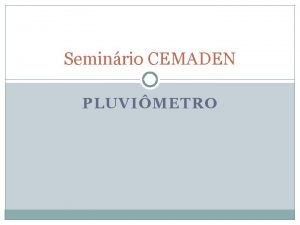










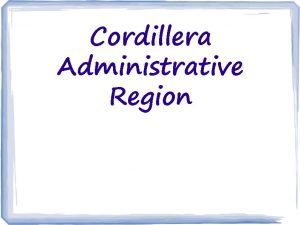











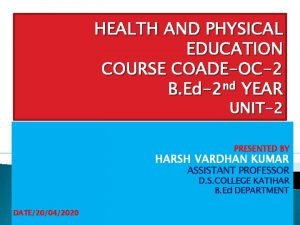


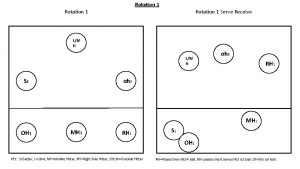


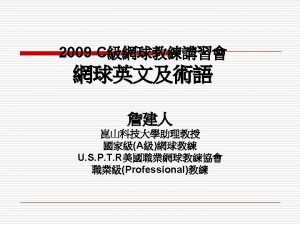
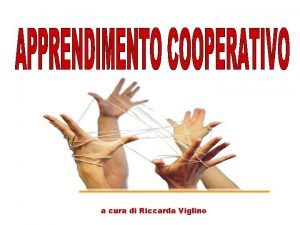
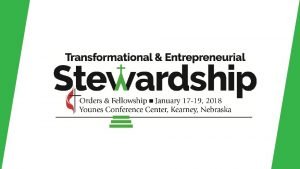


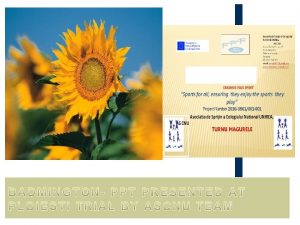










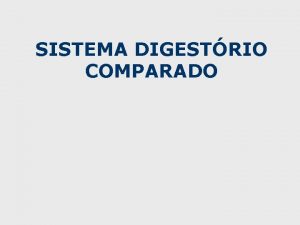

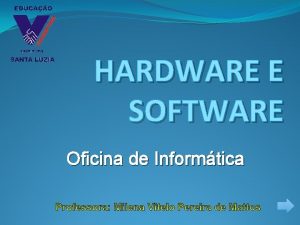
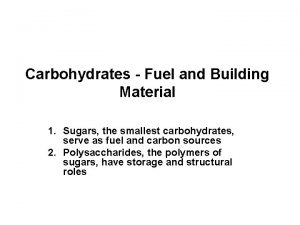







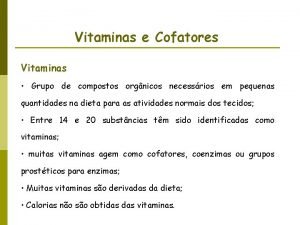


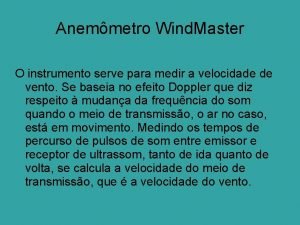

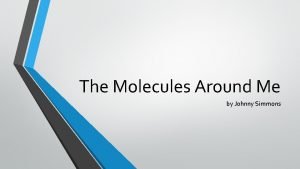





![A cosa serve il qualificatore di campo [1au]? A cosa serve il qualificatore di campo [1au]?](https://slidetodoc.com/wp-content/uploads/2021/03/4086907_1c9fab675e1f4d30c01688059e67c5eb-300x225.jpg)






